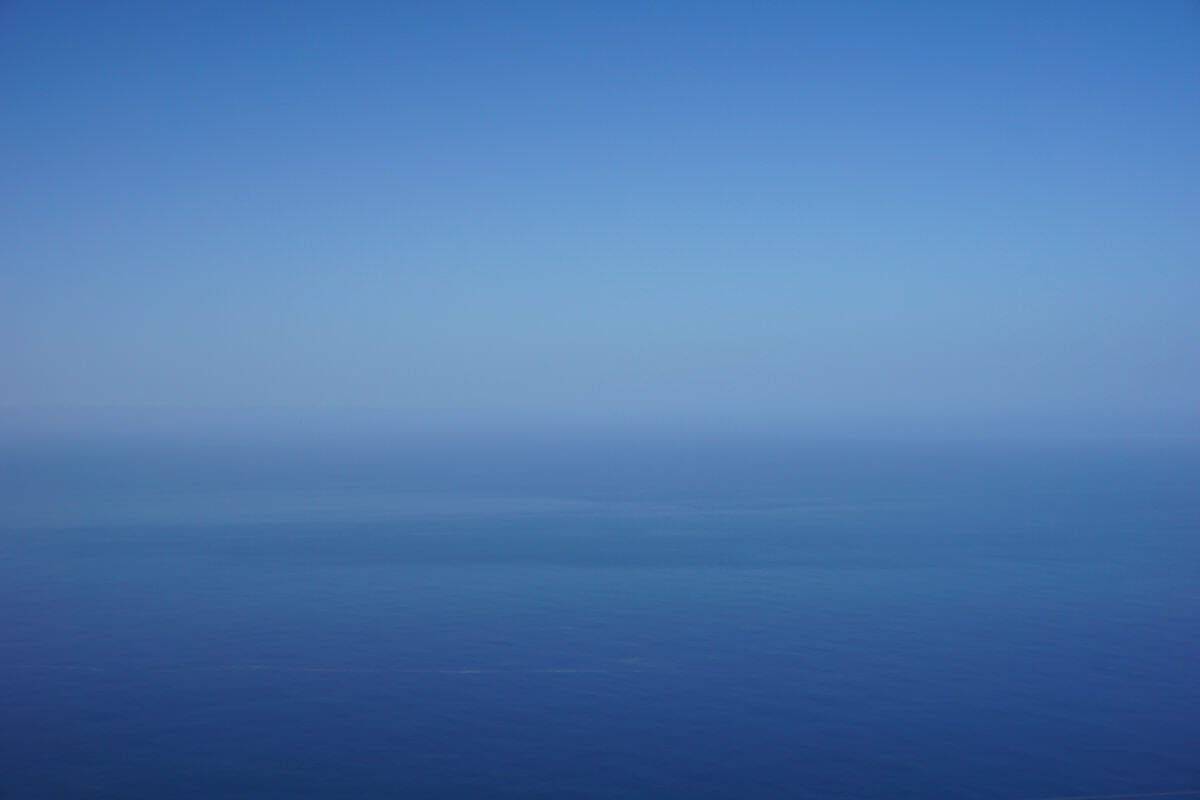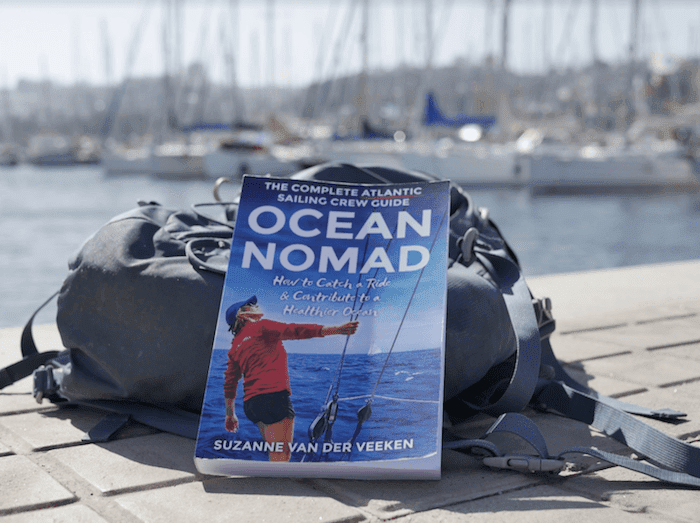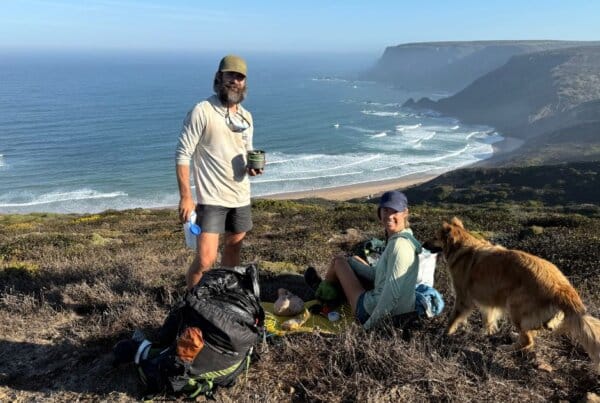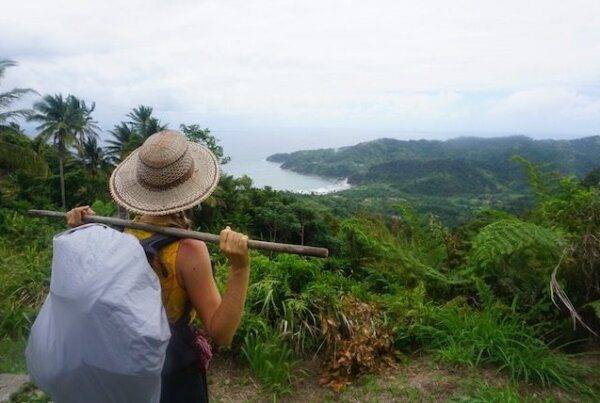Winter in Europe is coming, and many of us nomads, sailors, and vanlifers are slowly making way south. Southern Spain and Portugal are as far south and warm as you can get but it does get cold in the winter. How to extend the summer? But without flying? The Canary Islands are a happy, safe, warm, European destination solution :)
Table of Contents
- 1. Sail to the Canary Islands
- 2. Take a ferry from mainland Spain to the Canary Islands.
- The ferry companies operating mainland Spain – Canaries
- How much does the ferry cost to go to the Canary islands?
- The bookings process of the ferry
- What is the sleeping situation like on the ferry?
- How long is the ferry ride from mainland Spain the Canary Islands?
- Do people get seasick on the ferry?
- Is there wifi on the ferry?
- What to take on the ferry?
- Is it easy to move between islands with the campervan?
- What is the most environmentally friendly operating ferry to the Canary Islands?
- What is the most dog-friendly company operating a ferry to the Canary Islands?
- Discount for the ferry Spain to the Canary Islands
- Canary Islands Vanlife Adventure Guide
1. Sail to the Canary Islands

September, October, November is the time that many sailboats head south, either to spend the winter in the Canary Islands, or to sail across the Atlantic. Many of them welcome or even need extra crew members to make the voyage more fun, less tiring, safer, and more affordable.
I’ve written blogs and a book on hitchhiking / crewing on sailboats. It has been my lifestyle for many years, sailing +40.000 nautical miles on many different sailing vessels, of which 5 times across the Atlantic ocean. If you’re excited about this as a way of travel but have no idea where to start, you don’t have sailing experience, explore the blogs, my book, the ocean nomads community and the brand new Sailboat Travel Discovery course to learn all about travelling by sail as a crew member.
Winter 2025 / 2026 we also organize sailing trips in the Canary Islands. Learn More & Apply here.
2. Take a ferry from mainland Spain to the Canary Islands.
If you don’t want to sail or fly, there are ferries to Canary Islands from Spain making the 750 miles journey from the mainland. You can take your dog and camper van on the ferry to the Canary Islands. I’ve done this trip six times now and figured out a few things.
Taking the ferry from mainland Spain to the Canaries is not such a straightforward thing to do. They are often full, it’s expensive, and it’s a long ride.
The ride itself, the booking process, the time to prepare and recover, and a return trip to the Canary Islands will take about one week of your life and it's a considerable investment. Is it worth it? Here are some considerations and information about the ferry journey from mainland Spain to the Canary Islands.
You may also like reading: Vanlife Gift Ideas
The house is located in a remote area of Ecuador, specifically described as a treehouse-style house in a beach/jungle village. Unfortunately, the exact location isn't specified in the post, but it mentions being near a town surrounded by pristine jungle and having access to a surf break. If you're interested in similar locations, here are some treehouse options in Ecuador ¹ ²: – Eden Treehouse: Located in Pichincha, within the cloud forest of Mindo, ideal for birdwatching and nature lovers. – Casa de Vista Alta: In Mindo, offering accommodation with a garden, barbecue facilities, and a restaurant serving American cuisine. – Hacienda Chan Chan TreeHouse: Situated in Chiquintad, Azuay, a working dairy farm with beautiful views, fresh food, and hiking trails. – The Tree House: Located in Hacienda Estela, near Quito, offering a family-friendly stay with a garden and barbecue facilities. These options might give you a better idea of what to expect from a treehouse stay in Ecuador.
The ferry companies operating mainland Spain – Canaries
There are currently three ferry companies going to the Canary Islands from mainland Spain
Fred Olsen
The route of Fred Olsen is Huelva – Gran Canaria – Tenerife AND Gran Canaria- Tenerife – Huelva. There are two ferries weekly. One goes to Gran Canaria first, and then Tenerife. The other goes to Tenerife first, and then Gran Canaria.

Trasmediterranea
Trasmediterranea operates from Cadiz – Lanzarote – Fuerteventura – Gran Canaria – Tenerife – La Palma.
FRS / ARMAS
Currently, FRS/Armas collaborates with trasmediterranea. Tickets booked via FRS/Armas are operated by the Trasmediterranea The route of FRS / ARMAS is Cadiz – Lanzarote – Las Palmas – Tenerife – La Palma. On the way back this ferry also stops in Puerto Rosaria in Fuerteventura.
How much does the ferry cost to go to the Canary islands?
It ain’t cheap. And that’s a good thing. Only the real determined will make the voyage. Prices fluctuate a lot. The price depends on the size of your vehicle, the time of the year, and the class that you take. There are massive discounts for residents.
An average price for 1 person and 1 small camper is around 400 euro for the ‘Butaca’ option and 600 euros for a cabin option (one- way). Add a meter to your camper, and the prices will jump considerably. For the way back prices usually drop after March.
Here's a map where you can easily check prices and routes from the different ferry companies. Click on Cadiz and Huelva to see the options.
The bookings process of the ferry
You can book the ferry online, via the phone or via an associated office. The booking forms and process require details and patience. Or use a service like Ferryhopper to save some hassle. The ferryhopper system works way easier and faster than the direct websites of the ferries and the prices are the same.
What is the sleeping situation like on the ferry?
The budget option is ‘Butaca’ which gives you just a chair. Usually, they allow you to sleep on the floor. The comfort option gives you a cabin and food.
I’ve done 3 times the Butaca option and 3 times a cabin option when I managed to score for a pretty good deal. A cabin option makes quite a difference in arriving well rested and not having to spend another day recovering. You’ll have a bed (in a private cabin), a shower, and food included.
How long is the ferry ride from mainland Spain the Canary Islands?
The journey is roughly 750 miles. The ferry vessels operate at a speed of around 20 knots. It depends on the boat and your destination how much time it’ll take exactly. The journey will be somewhere between 27 – 40 hours.
From Huelva to the Tenerife or Gran Canaria it takes about 32 hours. If you leave the ferry at the second stop, you can add another 4 hours to it.
Do people get seasick on the ferry?
It happens. I’ve been close to it a few times. It all depends on the sea state. The ferry goes in pretty much every weather condition and there is way less movement as opposed to sailing. The last time I booked the ferry I picked a calm weather window where the swell was little. Here’s a blog on how to prepare for and deal with seasickness.
Is there wifi on the ferry?
Yes, there is. At a cost. Last ferry ride it was even for free. The beauty of navigating offshore is to be disconnected from the world wide web for a change. I’d say, embrace it!

Kobo Clara Ebook-reader
What to take on the ferry?
Here my personal ferry survival package:
- Sunglasses
- A thermos with tea
- Reusable cup
- Water filter
- A blanket. Sometimes it’s cold.
- A hat
- Fruit and food
- Comfortable clothes and layers. As you approach the Canaries, it gets warmer and warmer
- A good book or Ebook reader
- Downloaded music and earphones.
- Earplugs.
Is it easy to move between islands with the campervan?
Yes, there are multiple ferries operating, with Gran Canaria and Tenerife being central hubs. A one-way costs 40-150 euro for 1 person and a van depending on the distance.
What is the most environmentally friendly operating ferry to the Canary Islands?
There is none. It’s all pollutive, in terms of CO2 emissions, waste creation, and resource management. That said. These ferries are also used for transporting food to the islands. They are going anyway, as opposed to flights, which are mostly used for tourism purposes. This doesn’t justify you just take the ferry and you’re doing good for the environment. See what you can do. Take your responsibility. Give back to the environment in one way or the other.
On the ferry, lots of ‘disposable’ plastics are used for water, food, and even fruit is wrapped with plastic. You can make a difference here by showing up with your travel reusables, say no to plastic-wrapped items, and make some noise about the single-use plastic being used. Bring a water filter so you don’t have to buy 2 euro drinking water in a little plastic bottle.
I can highly recommend the Maunawai kini or the bottle that Maunawaii sells (5% discount). It allows me to never have to buy a plastic bottle again. AND the water is much healthier and tastier. It doesn't just take the pollution out, it gives minerals back. Also useful in the Canaries where tapwater is desalinated.
No information is present to educate the passengers on the resourcefulness of water. Educate yourself. Rethink Reuse refuse. Support Ocean Conservation.

Consider bringing your own apple ;)
What is the most dog-friendly company operating a ferry to the Canary Islands?
I have taken a dog with Baleria, Transmeditarenea, and Fred Olsen. It’s a tough experience for the dog. The least bad experience I’ve had with Transmeditarenea. You are able to let your dog walk freely. The worst experience I’ve had with Fred Olsen.
On the vessel I was on, the dog area is close to the engine and terrifies the dogs. Also, they were strict and few times to walk the dog. The dog had to be on a leash. My dog at the time doesn’t pee or pee when on a leash. It was very sad. They have numerous vessels though so it depends a little on that.
On vessel ‘Sardinia’ of Fred Olsen, I’ve seen better possibilities. Fred Olsen sometimes has cabins available in which you can take the dog. This is the best option so you can stay with your dog at all times. It comes at a price.
Discount for the ferry Spain to the Canary Islands
The Spanish autocaravan organisation La Paca offers a 15-40% discount on numerous ferries operating in Spain. This includes Fred Olsen, TransMediteranea, Armas, and Balearia and their route to and between the Canary Islands.
Here’s how it works. All communication goes in Spanish. They do not speak English.
- You register with La Paca. To do this you fill it out the form from your website and email it to them at administrativa@lapaca.org
- You wait for them to get back to you which usually takes 1-2 working days.
- You have to pay the yearly associate fee (60 euro for the first year, then 35 euro for the years after if you continue being socio) + one-time registry fee (15 euro). If you transfer from an international account, I recommend sending them a screenshot of your payment to speed up the process of registration.
- To book a ferry you have to download a form on the website of La Paca, corresponding with the ferry company. You fill it out and send it to barco@lapaca.org . La Paca forwards to form to the ferry and the ferry will apply the discount from reservations sent from La Paca. Usually, this is 30%, taken from the time the booking is processed.
- 1-2 days later you’ll receive an email from both the ferry company and La Paca with a ‘localizador.’ This is not a booking confirmation yet. Check if all the details are correct! On a few occasions, the wrong ‘seat’ was applied and the amount was higher than it was supposed to be.
- You have to pay the ferry by calling the ferry company and mention your credit card details. Once the ferry has been paid, your booking is confirmed. Also, you have to pay a 20 euro processing fee to La Paca. Opt for the phone numbers that do not start with 902. 902 numbers charge more.
- You only need to show your passport at the ferry.
La Paca works weekdays until 13.30 / 14.00 Spanish time. If you want to take advantage of the discounts it's best to anticipate and start to fill our forms at least a few days before you book the ferry. It’s a bit back and forth emailing and calling but the discount is considerable and often makes it worthwhile.
If you’re last minute with booking you may be better off booking straight with the ferry company. Often closer to date the ferry fees rise, and since making a booking via La Paca takes a few days the ferry rate may be higher by the time you’re booking request is processed.
Canary Islands Vanlife Adventure Guide
Coming early 2026! Pre-order today with a big discount!
After five winters exploring the Canary Islands in my van (and sailing between them), I’m gathering everything into one guide for people who want to slow travel Tenerife, Fuerteventura, Gran Canaria and Lanzarote in a simple, nature-focused way. Vanlife spots, island routes, water points, organic food resourcing, places, surf and hike suggestions, ferries, police tips, and the little lessons only years of system hacking reveals ;)
You can already secure the guide at an early-bird price while I’m finishing the final chapters (live from the Canaries:)). Early supporters also receive a bonus surprise!
Join the presale and I’ll send the guide as soon as it’s ready.
What else would you like to know about the ferry to the Canary Islands from mainland Spain?
Leave a comment here, and I can add it to the resource.
Last winters (2023/2024/2025) I spent nine months in Morocco and Western Sahara with the van. Another amazing winter destination with the van. I'm working on a little guidebook with all my tips. Join the waiting list here to get the beta-launch special in your inbox when it's done.























